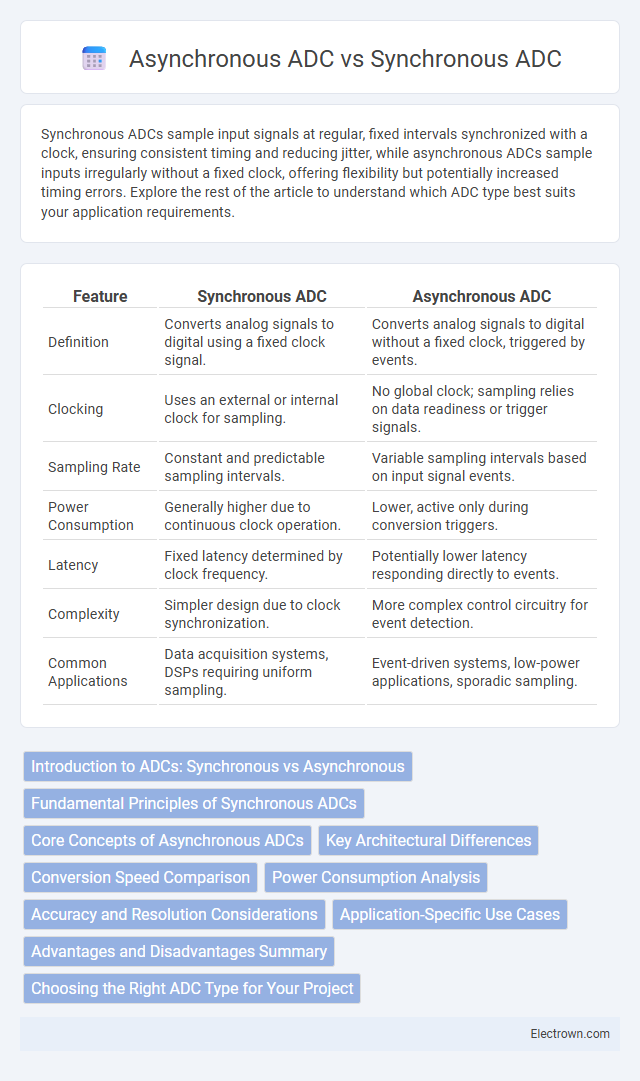Synchronous ADCs sample input signals at regular, fixed intervals synchronized with a clock, ensuring consistent timing and reducing jitter, while asynchronous ADCs sample inputs irregularly without a fixed clock, offering flexibility but potentially increased timing errors. Explore the rest of the article to understand which ADC type best suits your application requirements.
Table of Comparison
| Feature | Synchronous ADC | Asynchronous ADC |
|---|---|---|
| Definition | Converts analog signals to digital using a fixed clock signal. | Converts analog signals to digital without a fixed clock, triggered by events. |
| Clocking | Uses an external or internal clock for sampling. | No global clock; sampling relies on data readiness or trigger signals. |
| Sampling Rate | Constant and predictable sampling intervals. | Variable sampling intervals based on input signal events. |
| Power Consumption | Generally higher due to continuous clock operation. | Lower, active only during conversion triggers. |
| Latency | Fixed latency determined by clock frequency. | Potentially lower latency responding directly to events. |
| Complexity | Simpler design due to clock synchronization. | More complex control circuitry for event detection. |
| Common Applications | Data acquisition systems, DSPs requiring uniform sampling. | Event-driven systems, low-power applications, sporadic sampling. |
Introduction to ADCs: Synchronous vs Asynchronous
Synchronous ADCs operate with a clock signal that precisely controls the timing of the analog-to-digital conversion process, ensuring data sampling occurs at fixed intervals for high accuracy and consistency. Asynchronous ADCs, on the other hand, perform conversions triggered by events or signals without relying on a fixed clock, offering flexibility for irregular or event-driven sampling. The choice between synchronous and asynchronous ADCs depends on application requirements such as timing precision, power consumption, and signal characteristics.
Fundamental Principles of Synchronous ADCs
Synchronous ADCs operate by using a fixed, periodic clock signal to sample the input analog signal at precise intervals, ensuring uniform sampling times crucial for accurate signal reconstruction. This method allows the ADC to maintain synchronization with the system clock, reducing timing jitter and enabling precise digital representation of continuous signals. Your system benefits from synchronous ADCs in applications requiring consistent sampling rates and minimal phase error, enhancing signal integrity and overall performance.
Core Concepts of Asynchronous ADCs
Asynchronous ADCs operate without a global clock, converting analog signals at varying intervals based on signal activity, which reduces power consumption and latency. Their core concept involves event-driven sampling triggered by input changes rather than fixed-time sampling, enhancing efficiency for sporadic or irregular signals. Understanding how asynchronous ADCs dynamically adjust sampling aligns your choice with applications needing low power and real-time responsiveness.
Key Architectural Differences
Synchronous ADCs operate with a fixed clock signal that dictates the precise timing of sampling and conversion processes, ensuring uniform data acquisition intervals and simplified timing control. In contrast, asynchronous ADCs lack a global clock, relying on event-driven or self-timed mechanisms to initiate conversions, which allows for flexible sampling rates and potentially reduced power consumption. The architectural distinction centers on timing control: synchronous ADCs use centralized clock distribution, while asynchronous ADCs employ decentralized timing, impacting design complexity and application suitability.
Conversion Speed Comparison
Synchronous ADCs typically offer faster conversion speeds due to their clocked operation, which provides precise timing control and consistent sampling intervals. Asynchronous ADCs operate without a global clock, resulting in variable conversion times that may be slower and less predictable. For applications requiring high-speed and consistent data acquisition, your choice of a synchronous ADC can significantly improve overall system performance.
Power Consumption Analysis
Synchronous ADCs typically exhibit higher power consumption due to their reliance on continuous clock signals that drive conversion processes in real-time, whereas asynchronous ADCs consume less power by activating only when sampling is necessary, effectively reducing unnecessary switching activities. Your choice of ADC impacts power efficiency, especially in battery-powered or energy-sensitive applications where asynchronous ADCs can prolong operational time. Optimizing power consumption requires evaluating conversion speed, resolution, and sampling frequency demands inherent in the synchronous versus asynchronous architectures.
Accuracy and Resolution Considerations
Synchronous ADCs deliver higher accuracy by sampling input signals precisely aligned with a system clock, minimizing timing jitter and ensuring consistent data capture. Their resolution benefits from stable sampling intervals, allowing more precise quantization levels and reducing conversion errors. Asynchronous ADCs, lacking a synchronized clock, experience variable sampling intervals that can introduce timing uncertainty, negatively impacting accuracy and limiting effective resolution.
Application-Specific Use Cases
Synchronous ADCs excel in applications requiring precise timing synchronization, such as digital communication systems and radar signal processing, where accurate sampling aligned with a clock signal is critical. Asynchronous ADCs are preferred in event-driven or sporadic sampling scenarios, like sensor networks and low-power IoT devices, offering flexibility with variable sampling intervals. The choice depends on the application's timing requirements and power constraints, with synchronous ADCs favoring high-speed, consistent data acquisition, while asynchronous ADCs optimize for energy efficiency and irregular sampling demands.
Advantages and Disadvantages Summary
Synchronous ADCs offer precise timing control, resulting in high accuracy and improved signal integrity, while their reliance on a clock signal may introduce complexity and jitter issues. Asynchronous ADCs eliminate the need for a clock signal, reducing power consumption and simplifying design, but they can suffer from timing uncertainty and lower resolution. Your choice depends on balancing accuracy, power efficiency, and system complexity requirements.
Choosing the Right ADC Type for Your Project
When choosing the right ADC type for your project, consider that synchronous ADCs offer precise timing control and are ideal for applications requiring consistent sampling rates, such as digital signal processing and audio acquisition. Asynchronous ADCs, on the other hand, provide flexibility with variable sampling intervals, making them suitable for event-driven data acquisition or low-power applications. Your selection should align with the timing accuracy, power consumption, and processing requirements specific to your project's goals.
synchronous ADC vs asynchronous ADC Infographic

 electrown.com
electrown.com